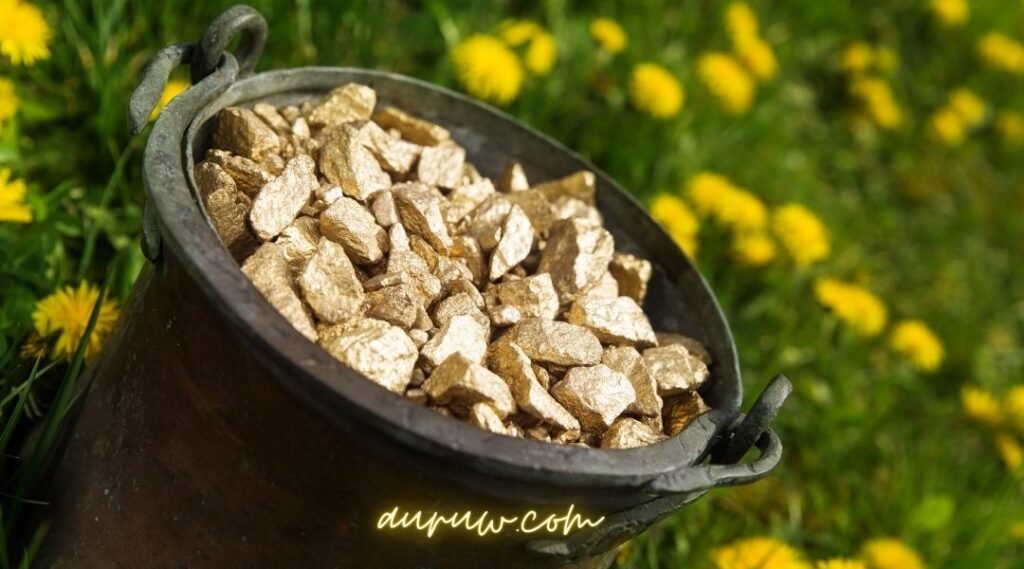Introduction
Natural gold nuggets are more than just raw metals; they are pieces of Earth’s history, coveted by collectors, investors, and artisans alike. These geological marvels represent millions of years of formation, offering both tangible and cultural value. This guide explores their origin, significance, and the best practices for purchasing and preserving them.
The Formation of Natural Gold Nuggets
Gold nuggets are typically formed through geological processes where molten gold from the Earth’s crust cools and solidifies. These processes often occur in quartz veins, followed by erosion that releases the nuggets into streambeds or placer deposits. Nuggets are classified into two main types:
- Placer Gold: Found in riverbeds, formed by erosion.
- Lode Gold: Embedded within rock formations.
Geographical Hotspots:
- Alaska and California in the U.S.
- Australia’s Golden Triangle.
- South Africa’s Witwatersrand Basin.
Historical Significance
Throughout history, gold nuggets have played pivotal roles:
- Gold Rush Era: Gold nuggets spurred major historical events, including the Klondike Gold Rush (1896) and the California Gold Rush (1848), shaping economies and societies.
- Cultural Symbolism: Gold has been a symbol of wealth, spirituality, and artistic inspiration, from Byzantine mosaics to modern jewelry.

Types of Natural Gold Nuggets
- Raw Nuggets: Unaltered and highly sought after for investment.
- Modified Nuggets: Polished or shaped for decorative purposes.
- Regional Variations:
- Alaskan Gold Nuggets: Known for their high purity.
- Australian Nuggets: Larger and more unique in shape.
How to Evaluate and Purchase Gold Nuggets
When buying gold nuggets, consider these factors:
- Weight and Purity: Higher karat values signify greater gold content.
- Provenance: Verify the origin of the nugget to ensure authenticity.
- Sellers and Platforms:
- eBay: Offers a wide range but requires caution against counterfeit products.
- Alaska Mint: Known for authentic, high-quality nuggets.
- Monarch Jewels: Focuses on artistic integration into jewelry.
Tips to Avoid Counterfeits:
- Insist on certificates of authenticity.
- Seek reviews and ratings for online sellers.
Investing in Gold Nuggets
Gold nuggets provide a dual benefit:
- Aesthetic Appeal: Ideal for collectors and art enthusiasts.
- Value Appreciation: Limited availability and increasing demand make them a solid investment.
Comparison with Other Gold Investments:
- Unlike gold bars, nuggets often appreciate due to their uniqueness and historical significance.
Caring for Gold Nuggets
Preservation tips:
- Cleaning: Use gentle soap and a soft brush to avoid scratching.
- Storage: Keep in airtight containers to prevent tarnishing.
- Environmental Protection: Avoid exposure to chemicals or humid conditions.
Natural Gold Nuggets in Jewelry
Gold nuggets are popular in jewelry for their unique, organic appearance. Designers often incorporate them into:
- Necklaces and pendants.
- Custom rings with raw nugget embellishments.
- Artistic trends like mixed-metal designs.

FAQs
Q: What makes gold nuggets unique?
A: Their natural formation, historical significance, and aesthetic appeal distinguish them from processed gold.
Q: How can I identify genuine nuggets?
A: Check for hallmarking, weigh against density standards, and buy from reputable sellers.
Q. Are natural gold nuggets worth more?
Yes, natural gold nuggets are typically worth more than refined gold because of their rarity and uniqueness. While the intrinsic value is tied to the gold content, collectors often pay a premium for size, shape, and historical significance.
Q: How to tell if a gold nugget is real gold?
A: To determine authenticity:
- Visual Inspection: Natural nuggets have irregular shapes and textures.
- Density Test: Gold is dense; compare the nugget’s weight to its size.
- Magnet Test: Real gold is non-magnetic.
- Acid Test: Use a gold testing kit to check purity levels.
Q: How pure are natural gold nuggets?
A: Purity varies by region. Nuggets typically range from:
- 70% to 95% purity (16-23 karats).
- High-purity nuggets are often found in regions like Alaska or Australia.
Q: Could the nugget be made of gold?
A: If it looks like gold but fails density or acid tests, it might be fool’s gold (pyrite) or another mineral. Verification by a jeweler or metallurgist is recommended.
Q: How much is a 5 lb gold nugget worth?
A: Calculation: Gold is priced per ounce; multiply current gold rates by 80 ounces (5 lbs).
- Additional Premium: Larger nuggets command collector premiums, potentially doubling or tripling their value.
Q: How much is 1 oz of gold today?
A: Gold prices fluctuate daily. As of now, 1 oz of gold is valued at approximately $2,700–$2,900 USD, depending on market conditions.
Q: How much is a 1 oz gold nugget worth?
A: Answer below:
- Base Value: The weight in gold (market rate for 1 oz).
- Collector Premium: Expect an extra 10%–50% depending on the nugget’s uniqueness and provenance.
Q: Are GOLDEN NUGGETS healthy?
A: If referring to the food item (chicken nuggets), their health depends on preparation:
- Homemade Versions: Healthier due to controlled ingredients.
- Store-Bought: Often high in fat, sodium, and preservatives.
